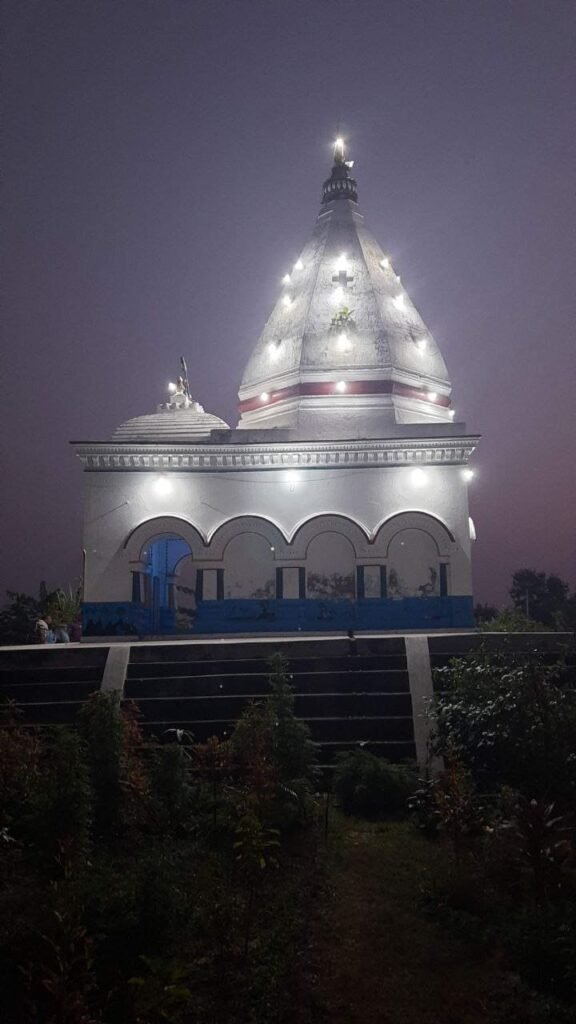
The types of Shivalaya or temples you might find around a 52 bigha pond on the outskirts of a village could vary based on regional and cultural factors. Here are some common types of Shivalaya:
- Traditional Temple: Often made from stone or brick, these temples have a sanctum (garbhagriha) where the Shiva lingam is worshipped. They might feature intricate carvings and a structured design.
- Simple Shrine: These could be smaller, more informal structures, sometimes just a raised platform or a small shed where the Shiva lingam or idol is placed.
- Natural Shrine: In some places, natural formations like rocks or trees are considered sacred and are worshipped as representations of Shiva.
- Modern Temple: These might have contemporary designs and facilities while still maintaining the essence of traditional worship.
- Village Shrine: Often simpler and more community-centered, these shrines might not have elaborate decorations but serve as important places of worship and gathering for the village.
- Ritualistic Temple: Sometimes, specific temples are dedicated to particular rituals or festivals related to Lord Shiva, and they might have specialized structures for these purposes.
Each type of Shivalaya reflects different aspects of local culture, architecture, and the way communities worship.
What is Required Kutri Shivalaya at 52 bigha beautiful pond outskit of village?
To determine the type of Shivalaya (temple dedicated to Lord Shiva) that would be appropriate for a 52 bigha (approximately 17 acres) pond on the outskirts of a village, you might consider the following factors:
- Purpose of the Temple:
- Community Worship: If the temple is intended for community worship, it should be spacious enough to accommodate villagers, with facilities for regular rituals and gatherings.
- Personal Worship: For personal or family worship, a smaller, more modest shrine might be sufficient.
- Cultural and Regional Preferences:
- Local architectural styles and cultural practices should guide the design. Traditional styles might involve intricate carvings and specific structures, while modern designs might be simpler.
- Location and Environment:
- Integration with Nature: Given the beautiful pond setting, a temple that harmonizes with the natural surroundings might be desirable. This could involve using natural materials and designs that blend with the landscape.
- Accessibility: Ensure the temple is easily accessible to villagers, with proper pathways and amenities.
- Size and Scale:
- Large Temple: A large, traditional temple might be appropriate if there is a significant number of visitors or if it serves as a major community center.
- Small Shrine: For a smaller, more personal space, a simple shrine or small temple could be constructed.
- Facilities:
- Sanctum Sanctorum: A space for the Shiva lingam or idol.
- Puja Area: An area for performing rituals and ceremonies.
- Pradakshina Path: A path around the temple for circumambulation.
- Resting Areas: Places for visitors to rest and gather.
- Water Facilities: Considering the proximity to a pond, incorporating water features or facilities could be beneficial.
- Maintenance and Sustainability:
- Design considerations should include ease of maintenance and sustainability, especially if the temple is to be a long-term feature of the area.
By balancing these factors, you can determine the most suitable type of Shivalaya for the location and its intended use.
Who is Required Kutri Shivalaya at 52 bigha beautiful pond outskit of village?
Determining who is required to establish or manage a Shivalaya (temple) on the 52 bigha pond on the outskirts of a village involves several considerations:
- Local Community:
- Village Elders and Leaders: They are often key in initiating and supporting the creation of a temple, as they represent the interests and needs of the local community.
- Local Devotees: Individuals who are dedicated to Lord Shiva and actively involved in religious practices may play a significant role in the establishment and management of the temple.
- Religious Organizations:
- Temple Trust or Committee: Establishing a trust or committee to oversee the planning, construction, and maintenance of the Shivalaya can ensure that the temple meets community needs and adheres to religious and cultural practices.
- Religious Leaders: Priests or religious figures who are knowledgeable about Shiva worship can provide guidance on the appropriate design, rituals, and management of the temple.
- Architects and Builders:
- Architects Specializing in Religious Architecture: They can design the temple to align with traditional styles and the natural surroundings of the pond.
- Builders and Contractors: Skilled professionals who can construct the temple according to the design and specifications.
- Funding and Financial Support:
- Donors and Sponsors: Financial support from the community, businesses, or individuals who wish to contribute to the temple’s construction and maintenance.
- Grants and Funding Agencies: In some cases, government or non-governmental organizations may provide grants for religious or community projects.
- Legal and Administrative Authorities:
- Local Government: They may be involved in granting permissions, ensuring compliance with regulations, and supporting the project from an administrative perspective.
- Legal Advisors: To handle any legal aspects related to land use, construction, and the establishment of a trust or committee.
- Environmental and Cultural Consultants:
- Environmental Consultants: To ensure that the temple’s construction and activities are environmentally sustainable, especially given the proximity to a pond.
- Cultural Consultants: To ensure that the design and practices align with local cultural traditions and respect the natural surroundings.
The establishment and management of a Shivalaya involve a collaborative effort among various stakeholders, including the local community, religious leaders, professionals, and administrative bodies.
When is Required Kutri Shivalaya at 52 bigha beautiful pond outskit of village?
The timing for establishing a Shivalaya (temple) at a 52 bigha pond on the outskirts of a village depends on several factors:
- Community Need:
- Current Demand: If the local community feels a need for a Shivalaya for regular worship or religious gatherings, this would influence the timing.
- Religious or Cultural Significance: Specific times might be chosen based on auspicious dates or festivals important to the community.
- Planning and Approval:
- Project Planning: Adequate time is needed for planning, designing, and securing approvals from local authorities and religious organizations.
- Land and Legal Formalities: Ensuring that all legal and land use permissions are in place can impact the timeline.
- Construction Schedule:
- Weather Conditions: Construction might be planned around favorable weather conditions, especially considering the proximity to a pond.
- Construction Time: The time required for building the temple, including foundation, structure, and finishing touches.
- Funding and Resources:
- Securing Funds: Availability of financial resources and fundraising activities can affect the timeline.
- Resource Availability: Availability of materials and skilled labor may also impact the schedule.
- Community Engagement:
- Participation and Support: Engaging with the community for support and involvement might dictate the timing of various stages of the project.
- Auspicious Dates:
- Religious Calendars: Many projects are timed to align with auspicious dates in the Hindu calendar, which could be significant for the dedication of the temple.
Typically, a project like this would be planned over several months to years, depending on the complexity and scale. The exact timing would be determined based on the readiness of all these factors and community input.
Where is Required Kutri Shivalaya at 52 bigha beautiful pond outskit of village?
The location of the Shivalaya (temple) within or around the 52 bigha pond on the outskirts of the village would depend on several factors:
- Proximity to the Pond:
- Near the Pond: If the temple is to be placed close to the pond, it could take advantage of the scenic beauty and tranquil environment. This location might also facilitate rituals involving water, such as abhishekam (ritual bathing of the deity).
- On the Pond’s Perimeter: Building the temple on the perimeter of the pond could provide easy access and maintain the natural landscape.
- Accessibility:
- Road Access: The temple should be located where there is easy access for villagers and visitors, possibly with pathways connecting it to the main village and road networks.
- Visibility: A location that is visible and prominent can help in making the temple a central point for the community.
- Land Use and Regulations:
- Land Allocation: Ensure the site is allocated properly and adheres to local land use regulations, especially if it’s close to a water body.
- Environmental Considerations: The site should be chosen to minimize impact on the pond’s ecosystem and ensure sustainability.
- Cultural and Religious Significance:
- Sacred Locations: In some traditions, specific locations near water bodies are considered more sacred. The temple might be placed in a way that aligns with these cultural beliefs.
- Design and Layout:
- Temple Design: The layout of the temple should consider the pond’s location to integrate natural elements and enhance the spiritual experience.
In summary, the Shivalaya should ideally be located in a way that balances accessibility, visibility, environmental impact, and religious significance. The final decision on the location would be made based on consultations with community leaders, architects, and environmental experts.
How is Required Kutri Shivalaya at 52 bigha beautiful pond outskit of village?
To determine how the Shivalaya (temple) should be designed and constructed at a 52 bigha pond on the outskirts of a village, several considerations come into play:
1. Design and Architecture
- Traditional vs. Modern: Decide between traditional architectural styles with intricate carvings and designs, or a more modern approach with minimalistic elements.
- Integration with Nature: Design the temple to harmonize with the natural beauty of the pond, using materials and colors that blend with the environment.
- Functional Layout: Include a sanctum sanctorum (garbhagriha) for the Shiva lingam or idol, a space for rituals, and possibly an open area for community gatherings.
2. Location and Placement
- Proximity to the Pond: Position the temple where it can benefit from the scenic views of the pond while ensuring it does not disrupt the natural habitat.
- Accessibility: Ensure the temple is easily accessible from the village with well-maintained pathways or roads.
3. Facilities and Amenities
- Worship Area: A dedicated space for performing rituals, including an altar or shrine for the Shiva lingam.
- Community Space: Areas for the community to gather, participate in events, and perform religious ceremonies.
- Resting Areas: Provide spaces for visitors to rest and reflect.
- Water Management: Consider incorporating water features or utilizing the pond for religious rituals, while ensuring environmental sustainability.
4. Aesthetic and Environmental Considerations
- Natural Elements: Use natural materials and incorporate landscaping that complements the pond and surrounding environment.
- Sustainability: Implement eco-friendly practices in construction and maintenance to preserve the pond’s ecosystem.
5. Cultural and Religious Aspects
- Auspicious Design: Align the design with traditional and cultural practices related to Shiva worship.
- Ritual Spaces: Design spaces for specific rituals and festivals associated with Lord Shiva.
6. Community Involvement
- Consultation: Engage with local community members, religious leaders, and architects to ensure the temple meets the needs and expectations of the villagers.
- Maintenance: Plan for the long-term upkeep of the temple with community involvement.
Overall, the Shivalaya should be designed to be a harmonious and functional space that respects the natural beauty of the pond while serving the spiritual and community needs of the village.
Case Study on Kutri Shivalaya at 52 bigha beautiful pond outskit of village?
A case study on establishing a Shivalaya (temple) at a 52 bigha (approximately 17 acres) pond on the outskirts of a village would involve detailed analysis and planning across various aspects. Here’s a structured approach to such a case study:
1. Introduction
Objective: To explore the feasibility, design, and impact of establishing a Shivalaya at a 52 bigha pond on the outskirts of a village.
Scope: This study covers the design and implementation of the temple, considering community needs, environmental impact, and cultural significance.
2. Background Information
Location: Describe the pond and its surroundings, including geographic and environmental features.
Community: Provide details about the village, including its demographics, cultural practices, and current religious facilities.
Need Assessment: Evaluate the current religious and cultural needs of the village and how a Shivalaya could address them.
3. Design and Planning
Site Selection:
- Location Analysis: Choose the optimal location around the pond for the temple, considering accessibility, views, and environmental impact.
- Land Use: Ensure compliance with local land use regulations and environmental protection guidelines.
Architectural Design:
- Temple Layout: Design the temple layout, including the sanctum sanctorum (garbhagriha), prayer halls, and community spaces.
- Integration with Nature: Ensure the design harmonizes with the natural landscape, incorporating local materials and aesthetic considerations.
Facilities:
- Worship Areas: Design spaces for daily rituals, festivals, and community gatherings.
- Amenities: Include resting areas, water management systems, and possibly an area for educational or cultural activities.
4. Environmental and Cultural Impact
Environmental Considerations:
- Impact Assessment: Assess potential impacts on the pond’s ecosystem and plan mitigation strategies.
- Sustainability: Implement eco-friendly construction practices and sustainable management of the pond and surroundings.
Cultural Significance:
- Community Engagement: Involve local community members in the planning process to ensure the temple meets cultural and religious expectations.
- Ritual and Festivals: Plan for space and facilities to accommodate important rituals and festivals associated with Lord Shiva.
5. Implementation Plan
Timeline:
- Planning Phase: Duration for design, approvals, and community consultation.
- Construction Phase: Time required for building the temple, including foundation, structure, and finishing touches.
- Operational Phase: Setting up management and maintenance plans.
Budget:
- Cost Estimates: Detailed budget covering construction, materials, labor, and ongoing maintenance.
- Funding Sources: Identify potential sources of funding, including donations, grants, and community contributions.
Legal and Regulatory Compliance:
- Permits: Obtain necessary permits and approvals from local authorities.
- Regulations: Ensure compliance with regulations related to construction, land use, and environmental protection.
6. Evaluation and Impact Assessment
Post-Implementation Review:
- Functionality: Evaluate the temple’s functionality and its ability to meet community needs.
- Community Feedback: Gather feedback from villagers on the temple’s impact and effectiveness.
Long-Term Impact:
- Cultural Impact: Assess how the temple influences cultural and religious practices in the village.
- Environmental Impact: Monitor the long-term environmental effects on the pond and surrounding area.
7. Conclusion
Summary: Recap the key findings and outcomes of the case study, including successes and challenges.
Recommendations: Provide recommendations for future projects based on the lessons learned from this case study.
8. Appendices
Supporting Documents:
- Design Plans: Architectural drawings and design documents.
- Community Surveys: Results from community needs assessments and consultations.
- Environmental Reports: Impact assessments and sustainability plans.
This case study would provide a comprehensive overview of the process involved in establishing a Shivalaya at the pond, including practical, environmental, and cultural considerations.
White paper on Kutri Shivalaya at 52 bigha beautiful pond outskit of village?
Establishing a Shivalaya at a 52 Bigha Pond on the Outskirts of a Village
1. Executive Summary
Objective: To provide an overview of the proposed establishment of a Shivalaya at a 52 bigha pond, including key benefits, challenges, and recommendations.
Scope: This white paper covers the rationale, design, implementation, and impact assessment of the temple project.
2. Introduction
Background: Describe the current situation, including the location of the pond, the village, and the existing religious and cultural context.
Purpose: Explain the purpose of the Shivalaya and its expected impact on the community and environment.
Scope of Study: Outline the areas covered in the white paper, including design considerations, environmental impact, and community benefits.
3. Project Justification
Community Needs:
- Current Religious Facilities: Overview of existing temples and their limitations.
- Cultural Significance: Importance of establishing a new Shivalaya for the local community.
Potential Benefits:
- Spiritual: Enhancing religious practices and community engagement.
- Cultural: Preserving and promoting cultural heritage.
- Economic: Potential for boosting local economy through tourism and related activities.
4. Design and Planning
Site Analysis:
- Location: Detailed description of the pond and surrounding area, including topography, accessibility, and environmental features.
- Design Considerations: Architectural design elements that integrate with the natural environment and local cultural aesthetics.
Temple Layout:
- Key Components: Sanctum sanctorum (garbhagriha), prayer halls, community spaces, and amenities.
- Environmental Integration: Use of local materials and design strategies that harmonize with the pond and natural surroundings.
Sustainability:
- Environmental Impact: Measures to minimize disruption to the pond’s ecosystem.
- Eco-friendly Practices: Sustainable construction practices and maintenance strategies.
5. Implementation Plan
Project Phases:
- Planning and Design: Timeline for obtaining approvals, finalizing designs, and preparing the site.
- Construction: Duration of construction activities, including site preparation, building, and finishing.
- Operational Setup: Establishing management structures, hiring staff, and setting up operational procedures.
Budget and Funding:
- Cost Estimates: Detailed breakdown of costs for construction, materials, and other expenses.
- Funding Sources: Identification of potential sources of funding, including donations, grants, and community contributions.
Legal and Regulatory Compliance:
- Permits: Required permissions and approvals from local authorities.
- Regulations: Compliance with construction, land use, and environmental regulations.
6. Community Engagement and Benefits
Stakeholder Involvement:
- Consultation Process: Methods for engaging with the community, religious leaders, and other stakeholders.
- Feedback Mechanisms: Ways to gather and incorporate community input into the project.
Expected Benefits:
- Community Impact: How the temple will address community needs and enhance social cohesion.
- Cultural Preservation: Contributions to preserving and promoting local traditions and practices.
7. Risk Management
Potential Risks:
- Environmental Risks: Impact on the pond’s ecosystem and mitigation strategies.
- Construction Risks: Possible delays or cost overruns and contingency plans.
- Community Risks: Ensuring that the project meets community expectations and managing any conflicts.
Mitigation Strategies:
- Preventive Measures: Steps to avoid or reduce identified risks.
- Response Plans: Procedures for addressing issues if they arise.
8. Evaluation and Monitoring
Performance Metrics:
- Success Indicators: Criteria for evaluating the success of the project, including community satisfaction, environmental impact, and financial performance.
Monitoring Plan:
- Ongoing Assessment: Regular reviews of the temple’s operations, environmental impact, and community feedback.
- Reporting: Mechanisms for reporting on project outcomes and addressing any issues.
9. Conclusion and Recommendations
Summary: Recap the key findings and recommendations based on the analysis.
Action Steps: Outline the immediate next steps for moving forward with the project, including securing funding, finalizing designs, and initiating construction.
10. Appendices
Supporting Documents:
- Design Plans: Architectural drawings and designs.
- Community Surveys: Results from consultations and needs assessments.
- Environmental Reports: Impact assessments and sustainability plans.
This white paper will provide a comprehensive overview of the proposed Shivalaya project, addressing all critical aspects from design to implementation and impact assessment.
Industrial Application of Kutri Shivalaya at 52 bigha beautiful pond outskit of village?
Exploring the industrial applications of a Shivalaya (temple) at a 52 bigha pond on the outskirts of a village involves looking beyond traditional religious functions and examining how such a project might contribute to industrial and economic development. Here are several potential industrial and economic applications:
1. Tourism Development
Cultural Tourism:
- Religious Tourism: Attract tourists interested in religious and cultural heritage, which can boost local businesses such as hotels, restaurants, and souvenir shops.
- Eco-Tourism: Leverage the scenic beauty of the pond and the temple to attract visitors interested in nature and environmental conservation.
Infrastructure Improvement:
- Transportation: Development of better road access to the temple can improve connectivity and support local transportation services.
- Public Facilities: Construction of facilities like restrooms, information centers, and parking areas can enhance the visitor experience.
2. Community Development
Economic Opportunities:
- Employment: Creation of jobs related to the temple’s operation, maintenance, and visitor services.
- Skill Development: Opportunities for local residents to gain skills in hospitality, management, and cultural preservation.
Local Business Support:
- Crafts and Artisans: Encourage the growth of local crafts and artisan businesses by providing a platform for their products to be sold to visitors.
- Agricultural Benefits: Use the increased footfall to support local agricultural markets and produce sales.
3. Environmental and Sustainability Projects
Conservation Efforts:
- Pond Management: Implement sustainable practices for managing the pond, including water conservation, waste management, and habitat preservation.
- Green Initiatives: Incorporate green technologies and eco-friendly practices in the temple’s construction and operation, such as solar energy and rainwater harvesting.
Education and Awareness:
- Environmental Education: Use the site as a center for educating visitors and locals about environmental conservation and sustainable practices.
- Cultural Programs: Host workshops and programs that promote cultural and environmental awareness.
4. Social and Cultural Impact
Community Engagement:
- Cultural Events: Organize cultural festivals, religious events, and community activities that foster social cohesion and cultural exchange.
- Volunteer Programs: Engage volunteers in temple maintenance, community service, and event organization.
Health and Well-being:
- Spiritual Well-being: Provide a space for meditation, prayer, and spiritual activities that contribute to the mental and emotional well-being of the community.
- Recreational Space: Utilize the temple and pond area as a recreational space for community events, sports, and leisure activities.
5. Innovation and Research
Architectural and Environmental Innovation:
- Design Research: Use the project as a case study for innovative temple designs that integrate traditional architecture with modern sustainability practices.
- Environmental Research: Study the impact of the temple and its operations on the local ecosystem and explore ways to mitigate negative effects.
Cultural Research:
- Historical Studies: Research the historical and cultural significance of the site, contributing to broader academic knowledge and preserving local heritage.
6. Potential Partnerships and Funding
Public-Private Partnerships:
- Collaborations: Partner with private companies, NGOs, and government agencies to support the development and sustainability of the project.
- Grants and Sponsorships: Seek grants and sponsorships for environmental, cultural, and community development projects associated with the temple.
Investment Opportunities:
- Commercial Ventures: Explore commercial opportunities such as establishing visitor centers, cafés, or souvenir shops that complement the temple’s offerings.
Incorporating these industrial and economic applications can maximize the benefits of the Shivalaya project, supporting not only religious and cultural goals but also contributing to the economic development and sustainability of the area.






